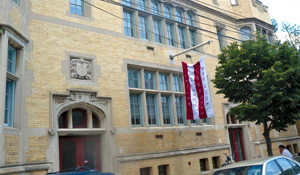For more than a decade, a court for people who live in and around Red Hook has emphasized problem-solving over jail for many criminal offenders. Its success has helped change the neighborhood for the better.

The Red Hook Community Justice Center has served as a model court where the goal is rehabilitation and remediation, so that the offender does not wind up back in court but rather contributes positively to the community. In May, trustees of the Park Slope Civic Council visited the center, at the invitation of Kings County District Attorney Charles J. Hynes, to get an inside look at this example of progressive, humanist approaches to criminal justice.
The center, housed in a converted school building, grew out of a low point for Red Hook, in 1990. While searching for a student who had run out of local P.S. 15 after a fight, Principal Patrick Daly was killed in gang crossfire. Hynes successfully prosecuted the principal’s killers. He also made a commitment to creating criminal justice solutions for Red Hook, then one of the most dangerous neighborhoods in the city.
Hynes has become a national leader in “diversion” strategies. He believes violent criminals belong in jail, but nonviolent offenders and the community at large can best be served by sentences that focus on rehabilitation, education, and prevention. Diverting nonviolent offenders from prison also saves the community money, as rehabilitation, education, and prevention programs cost about half as much as incarceration.
The approach is particularly valuable in addressing the problem of youth crimes. “Juveniles have a 78% recidivism rate within three years,” Hynes told the Brooklyn Daily Eagle. Mincing no words, he added: “The institution [of juvenile detention facilities in New York], objectively speaking, is an obscenity for the government. They’re ticking time bombs with no reentry skills.”
The court handles only nonviolent misdemeanor cases, but these can include drug and domestic violence cases, landlord-tenant disputes, and family-court matters. Judge Alex M. Calabrese is the sole judge; he treats everyone with respect, often praising offenders for positive steps. Affirmations like “you’ve done a good job” and “congratulations” can be heard over and over in his courtroom. Simply put, this judge cares.
When crafting sentences, the judge strives to address the needs of the victim, compensate the community, and offer the defendant services designed to reduce the chances for recidivism. For example, a high school student before the court on a marijuana charge might be told that all charges will be dropped if he stays out of trouble with the law and improves his grades. A panel of peers might review his case, and he might be given a community-service assignment.
The court provides offenders with services and incentives to stay out of trouble. Calabrese made it clear, however, that if they take advantage of the system by not doing the right thing, they will get even tougher sentences than in other courts. These harsher punishments are imposed to protect the broader community, which is the system’s ultimate goal.
Court systems from around the world are beginning to emulate this model for community justice across the globe, from as far away as Liverpool, England, and New Zealand.
The Community Justice Center has also helped transform Red Hook from one of the most dangerous neighborhoods into a thriving community — one of the 15 safest in the city. It will serve as a model for the next such court, slated for Brownsville, another troubled area.
— Cathy Sokil Milnikiewicz is a Civic Council trustee.
from the Summer 2012 Civic News

